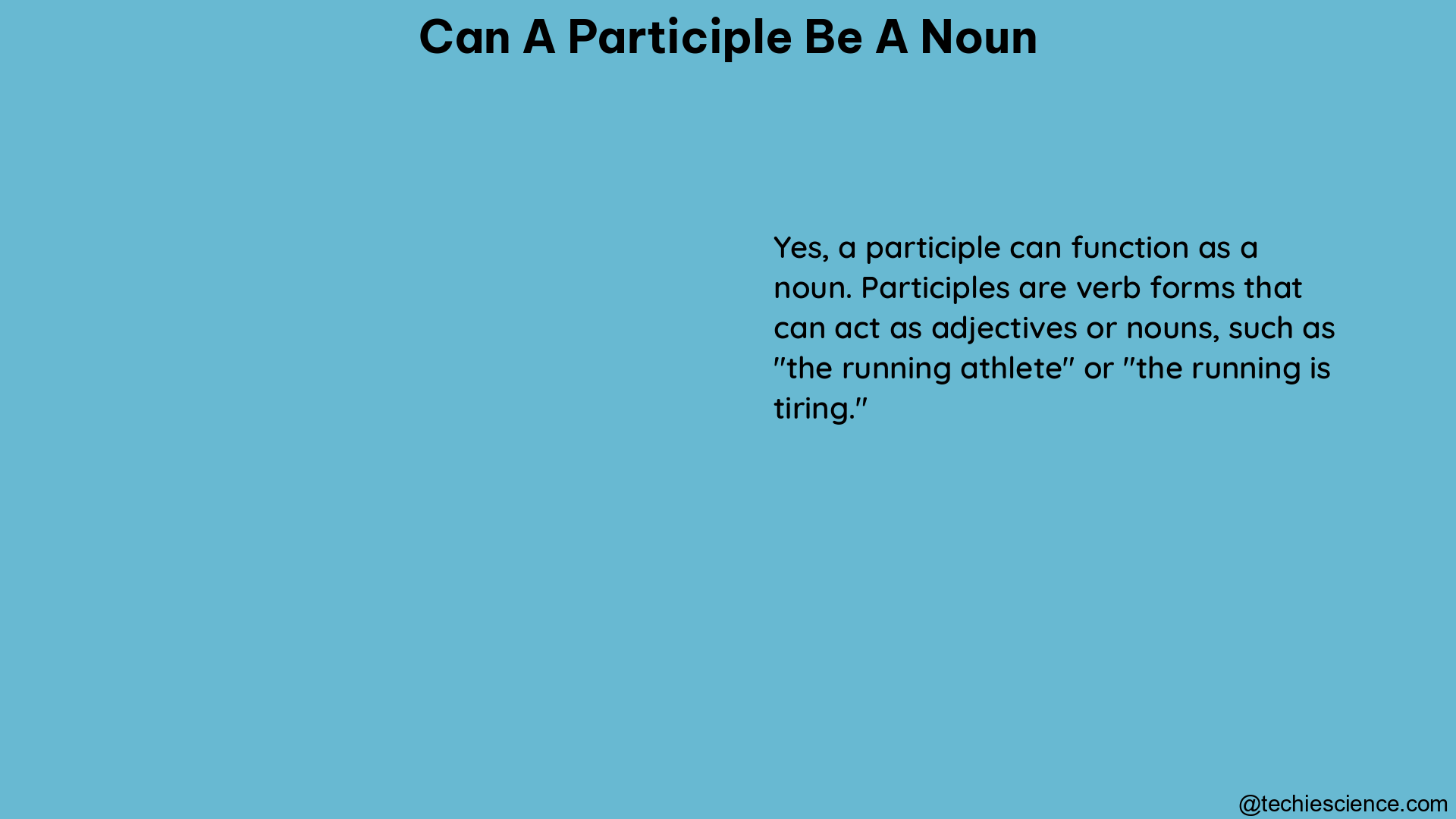Participles are a unique grammatical construct in the English language, often causing confusion for students and writers. This comprehensive guide will delve into the nuances of participles, exploring whether they can indeed function as nouns and providing detailed examples to illustrate their usage.
Understanding Participles
Participles are verb forms that serve as adjectives, modifying nouns or pronouns in a sentence. There are two main types of participles:
-
Present Participles: These participles end in “-ing” and describe an ongoing action or state of being. For example, “The running dog chased the cat.”
-
Past Participles: These participles typically end in “-ed,” “-en,” “-d,” “-t,” “-n,” or “-ne” and describe a completed action or state of being. For example, “The broken vase was on the table.”
Participles are versatile grammatical elements that can be used in various ways, including as part of participial phrases, which provide additional information about a noun or pronoun.
Participles as Adjectives

The primary function of participles is to act as adjectives, modifying nouns or pronouns in a sentence. This is the most common use of participles in the English language. For example:
- The crying baby needed attention.
- The wrecked car was towed away.
- The smiling woman greeted the customers.
In these examples, the participles “crying,” “wrecked,” and “smiling” are used to describe the nouns “baby,” “car,” and “woman,” respectively.
Participles in Participial Phrases
Participles can also be part of participial phrases, which are groups of words containing a participle and its modifiers or related (pro)nouns. These phrases can be placed at the beginning, middle, or end of a sentence, and their placement affects the punctuation used. For instance:
- Smiling brightly, the child waved to her parents.
- The child, waving excitedly, ran towards the ice cream truck.
- The child waved to her parents, her smile beaming.
In these examples, the participial phrases “Smiling brightly,” “waving excitedly,” and “her smile beaming” provide additional information about the child’s actions and state of being.
Can Participles Be Used as Nouns?
While participles are primarily used as adjectives, there are instances where past participles can be used as nouns, particularly when they are used to describe a group or category of people. Some examples include:
- We fear the damned.
- He honored our fallen.
- This is a given.
- You are the chosen.
- The lost were among us.
- They obey the venerated.
- My beloved kissed me.
In these cases, the past participles “damned,” “fallen,” “chosen,” “lost,” “venerated,” and “beloved” are functioning as nouns, referring to specific groups or individuals.
It’s important to note that this usage of participles as nouns is relatively limited and specific. Participles are not typically considered to be nouns in the broader sense of the word. They are primarily verb forms that serve as adjectives, modifying nouns or pronouns in a sentence.
Identifying Participles and Their Functions
To determine whether a participle is being used as an adjective or a noun, consider the following:
- Adjective Usage: If the participle is modifying a noun or pronoun, it is being used as an adjective.
-
Example: The running dog chased the cat.
-
Noun Usage: If the participle is being used to refer to a group or category of people, it may be functioning as a noun.
- Example: The chosen were honored at the ceremony.
It’s also important to consider the context of the sentence and the overall meaning to accurately identify the role of the participle.
Conclusion
While participles are primarily used as adjectives, modifying nouns or pronouns, there are instances where past participles can be used as nouns, particularly when describing groups or categories of people. However, this usage is relatively limited, and participles are not typically considered to be nouns in the broader sense of the word. Understanding the nuances of participles and their functions is crucial for effective and accurate communication in the English language.
References
- Purdue OWL. (n.d.). Participles. Retrieved from https://owl.purdue.edu/owl/general_writing/mechanics/gerunds_participles_and_infinitives/participles.html
- English Stack Exchange. (2012). Past participle used as a noun? Retrieved from https://english.stackexchange.com/questions/77587/past-participle-used-as-a-noun
- Study.com. (2021). How to Identify Participles and What They Modify. Retrieved from https://study.com/skill/learn/how-to-identify-participles-and-what-they-modify-explanation.html
- Grammarly. (2022). What Is a Participle? Definition and Examples. Retrieved from https://www.grammarly.com/blog/participle/
- ESU Writing Studio. (n.d.). Participles and Participle Phrases. Retrieved from https://www.esu.edu/writing-studio/guides/participles.cfm
Hi…I am Philomina Jose, M.A., B.Ed. in English Language and Literature with KTET and four years of teaching experience both in Kerala as well as abroad. I am always interested to learn new things and LambdaGeeks has actually favoured me in that task.